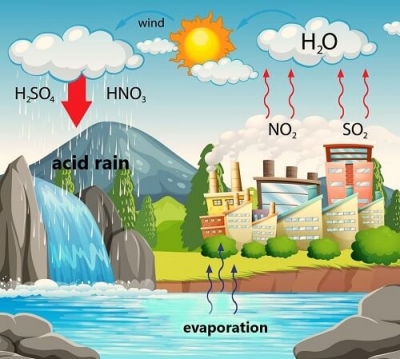
A broad term that includes all forms of precipitation with acidic components like sulphuric acid or nitric acid, acid rain, or acid deposition, falls to the ground in wet or dry forms from the atmosphere. When sulphur dioxide or nitrous oxides emitted into the atmosphere react with Oxygen, water and other chemicals it forms acids, which then further mix with water and other materials before falling to the ground as rain, hail, snow, fog, or even acidic dust.
What are the effects of acid rain?
The ecological consequences of acid rain are seen most strongly in marine habitats, such as streams, lakes and marshes where fish and other wildlife can be toxic. Acidic rainwater can leach aluminium from soil clay particles as it flows through the soil and then floods into streams and lakes.
What will happen if we don’t stop acid rain?
Sulphur dioxide and nitrogen oxide are the principal chemicals for acid rain. It can also influence humans since the acid goes into fruits, vegetables and animals. In other words, we can get really sick if acid rain doesn’t stop, and we eat those things. In general, acid rain affects men, but not directly.
What is acid rain? What are its harmful effects?
It has been shown that acid rain has detrimental effects on trees, freshwaters and soils, destroys insects and aquatic life-forms, causes paint to peel, corrosion of steel structures such as bridges, and weathering of stone buildings and sculptures, as well as impacts on human health.
What are three ways to reduce acid rain?
Alternative energy sources should be used, such as solar and wind power. Renewable sources of energy are helping to reduce acid rain, as they produce much fewer emissions. There are other electricity sources as well, such as nuclear power, hydropower, and geothermal energy. Among these, the most extensive use is among nuclear and hydropower.
How does acid rain affect plants?
Acid rain can affect the health of plants. Acid rain changes the pH of the land where the plant is growing, thereby affecting the overall growth of the plants. Moreover, it binds or dissolves essential soil minerals such as nitrogen and phosphorus and carries them away.
What is acid rain made of?
Acid rain comprises highly acidic water droplets due to air emissions, specifically the disproportionate levels of sulphur dioxide and nitrogen dioxide emitted by vehicles and manufacturing processes. Sulphur dioxide and nitrogen dioxide combine with water molecules to form sulphuric and nitric acid.
What is the primary source of acid rain?
The power plants primarily cause acid rain. It releases most of the sulphur dioxide and nitrogen dioxide while burning fossil fuels. Sulphur dioxide and nitrogen dioxide combine with water molecules to form sulphuric and nitric acid causing acid rain.
Can acid rain damage buildings?
Yes, acid rain harms buildings. It strips away the materials and corrodes the metals of the buildings. Example: Tarnishing of Taj Mahal.
Can acid rain burn your skin?
No, acid rain can not burn the skin.
Picture Credit : Google




